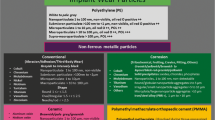Summary
On the basis of the newly-formed capsular tissue of 80 cemented (Weber-Huggler, Müller-Charnley) and uncemented (ceramic/ceramic/titanium) total hip endoprostheses which had to be reoperated on because of aseptic loosening, the efficiency of the Sudan-III-staining reported in literature to identify polymethylmethacrylate (PMMA) bone cement particles is investigated, because the quantity as well as quality of the various wear products is discussed as possible factors of prostheses loosening.
PMMA-, polyethylene and polyester particles show definite sudanophilia and orange-red coloration in the Sudan-III-stained frozen sections, so that only very large wear products utilizing the knowledge of the materials of the artificial joints used can be recognized by their forms, whereas the wear stored in the macrophages cannot be identified.
Thus, Sudan-III-staining is not suitable for guaranteeing identification and determination of the amount of PMMA-wear.
Zusammenfassung
Anhand des Regeneratkapselgewebes von 80 zementierten (Weber-Huggler, Müller-Charnley) und nicht zementierten (Keramik/Keramik/Titanium) totalen Hüftendoprothesen, die wegen aseptischer Prothesenlockerung reoperiert werden mußten, wird die Aussagekraft der in der Literatur zur Identifikation von Polymethylmethakrylat (PMMA)-Knochenzement angegebenen Sudan-III-Färbung überprüft, da sowohl die Quantität als auch die Qualität der verschiedenen Abriebfragmente als mögliche Prothesenlockerungsfaktoren diskutiert werden.
PMMA-, Polyäthylen- und Polyesterabriebteilchen zeigen im Sudan-III gefärbten Gefrierschnitt eine deutliche Sudanophilie und orangerote Färbung, so daß nur sehr große Abriebfragmente bei Kenntnis der verwendeten Werkstoffpaarungen an der Form erkannt werden können, während sich der in Makrophagen gespeicherte Abrieb der Beurteilung entzieht.
Die Sudan-III-Färbung ist somit nicht geeignet, eine Identifikation und Mengenbestimmung von PMMA-Abrieb zu gewährleisten.
Similar content being viewed by others
References
Bösch P, Harms H, Lintner F (1982) The proof of dimethylparatoluidine in bone cement even after long-time implantation. Arch Toxicol (in press)
Brinkmann KE, Heilmann K (1974) Klinische, röntgenologische und feingewebliche Untersuchungen an ausgelockerten Hüftgelenksprothesen. Arch Orthop Unfall Chir 80:333–342
Bullough PG (1978) Tissue reaction of wear debris generated from total hip replacements. In: Nas ser eftekhar principles of total hip arthroplasty. The C. V. Mosby, St. Louis
Crugnola, A, Schiller A, Radin E (1977) Polymeric debris in synovium after total joint replacement: histological identification. J Bone Jt Surg 59-A:860–862
Jozsa L, Reffy A (1980) Histochemical and histophysical detection of wear products resulting from prostheses. Folia Histochem Cytochem 18:195–200
Leugering HJ, Püschner H (1978) Identification of wear particles in tissue after implantation of different plastic materials. J Biomed Mat Res 12:571–578
Lintner F, Bösch P, Brand G (1982) Histologische Untersuchungen über Umbauvorgänge an der Zement-Knochengrenze bei Endoprothesen nach 3- bis 10jähriger Implantation. Pathology Prac Res 173:376–389
Lintner F, Bösch P, Brand G, Harms H (1982) Die Mineralisationsstörung an der Zement-Knochen-Grenze bei totalen Endoprothesen. Acta Med Aust [Suppl] 23:3, 25
Mendes DG, Walker PS, Figarola F, Bullough PG (1974) Total surface hip replacement in the dog. Clin Orthop Rel Res 100:256–264
Pedley RB, Meaching G, Gray T (1979) Identification of acrylic cement particles in tissues. Ann Biomed Eng 7:319–328
Willert HG, Buchhorn G, Zichner L, Müller K, Semlitsch M (1979) Oberflächenstrukturen von Knochenzement. Z Orthop 117:674–683
Willert HG, Frech HA (1976) Tissue damage caused by bone cement. In: Gschwend N, Debrunner HU (eds) Total hip prosthesis. Hans Huber, Bern Stuttgart Wien, pp 240–242
Willert HG, Semlitsch M (1975) Kapselreaktion auf Kunststoff-und Metallabrieb bei Gelenkendoprothesen. Techn Rundschau Sulzer 2
Author information
Authors and Affiliations
Rights and permissions
About this article
Cite this article
Lintner, F., Bösch, P. & Brand, G. The efficiency of the Sudan-III-staining to identify wear particles of PMMA-bone cement in tissue after total endoprostheses. Arch. Orth. Traum. Surg. 100, 79–81 (1982). https://doi.org/10.1007/BF00462343
Received:
Issue Date:
DOI: https://doi.org/10.1007/BF00462343




